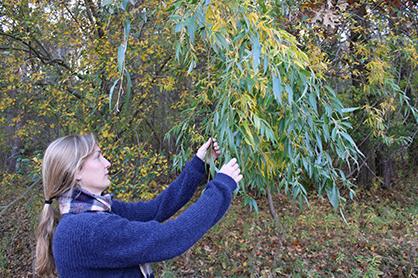From restaurants to classroom: Assistant Professor Cat Clark transforms her love of agriculture (and food) into lab work for her Botany students

Cat Clarke ran a student farm when she was studying environmental science at Stockton University. She had worked for a farm-to-table restaurant earlier, and she carried her experiences with food into graduate school, where she studied the biology of tea plants.
These days, an Alfred University assistant professor of Genetics/Plant Biology/Biostatistics in the Division of Biology/Biochemisty, College of Liberal Arts and Sciences, she has adapted her interest in plants and farming to the classroom.
Her Botany class recently conducted lab work on pigments derived from plants, with Clarke’s students using plants she had gathered around her home in Almond and on the Alfred University campus. Clarke and her students used the plants to create different dyes and then experimented with the effects of the dyes on different materials, including yarn and tea towels.
The plants included willow, which produced a rusty-orange dye; golden rod, a sunny yellow color; aspen leaves, a softer shade of yellow; wild grapes, a deep purple coloring; and staghorn sumac, an orange-pink tint.
“I just picked them around the campus and on the side of the road,” Clarke says.
She designed the lab work to be a lesson in plant-derived pigments, of which there are three major groups, or classes: chlorophyll, which produces a green base; carotenoids, which produce colors on the red-orange-yellow spectrum; and flavonoids, which produce blues, reds, and purples.
After extracting pigments from the plants, Clarke’s Botany students applied the dyes to both plant-based and protein-based fabrics, such as wool. The students recorded the results, comparing the effects of different dyes on different kinds of fabrics, and collected and analyzed the data in their lab reports.
Clarke joined the Alfred University faculty this year after earning her PhD at the University of Florida, in Gainesville, FLA. Her Botany class has provided her with the opportunity to transform her prior work in agriculture into a unique classroom activity.
“It’s a new experience based on my old experiences,” she says. “The results I’m seeing from my students will shape and improve the work as I keep teaching.”
